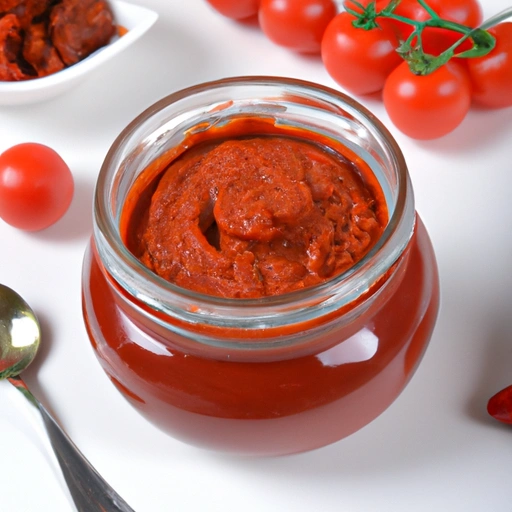Tomato Sauce
Description

Tomato sauce is a savory, versatile ingredient derived from fresh tomatoes that have been cooked down, sometimes seasoned, and then blended to a desired consistency. It can range from a thick, rich concentrate to a more liquid, pourable sauce. Tomato sauce is an essential pantry staple in many cultures and is recognized for its bright red color, tantalizing aroma, and deep, mellow flavor that can enhance a wide array of dishes. It is measured in various units, including cups and fluid ounces in American recipes, and milliliters and liters in European recipes, with 1 cup being approximately 237 mL, and 1 fluid ounce equaling about 29.57 mL.
Common uses
Tomato sauce is commonly used as a base for pasta dishes, pizzas, stews, soups, and as a condiment or dip. It can be flavored with herbs, spices, and other ingredients like garlic, onions, or vegetables to enhance its taste.
Nutritional value
Calories
Tomato sauce is generally low in calories, with approximately 20-80 calories per 100g (about 3.5 oz), depending on the recipe and added ingredients.
Protein
Tomato sauce contains about 1-2g of protein per 100g serving, which can contribute to daily protein intake.
Fat
Most tomato sauces are low in fat, typically containing less than 1g of fat per 100g serving unless additional fat is added during preparation.
Carbohydrates
Carbohydrates in tomato sauce primarily come from the natural sugars in tomatoes, with a 100g serving containing around 5-10g of carbohydrates.
Vitamins
Tomato sauce is a good source of vitamin C and provides various B vitamins, particularly vitamin B6 and niacin.
Minerals
Rich in potassium and also contains magnesium, iron, and phosphorus, tomato sauce contributes to the mineral content of a balanced diet.
Health benefits
Tomato sauce is rich in antioxidants such as lycopene, which may contribute to heart health and reduce the risk of certain cancers. The vitamins and minerals present in tomato sauce support immune function and bone health.
Potential risks
Some store-bought tomato sauces can contain high levels of sodium and added sugars, which may not be suitable for those with hypertension or diabetes. Additionally, individuals with acid reflux may need to limit their consumption due to tomato sauce's acidity.
Common recipes
Tomato sauce is featured in a variety of recipes including marinara sauce, arrabbiata sauce, and as a base for meat sauces such as Bolognese. It is also used in chili con carne, ratatouille, and shakshuka.
Cooking methods
It can be slow-cooked to develop depth of flavor or used straight from a can or bottle for convenience. Some recipes call for reducing the sauce to thicken it, while others use it in its thinner form.
Pairing with other ingredients
Tomato sauce pairs well with pasta, rice, and grains, as well as proteins like chicken, beef, pork, and seafood. It complements vegetables such as zucchini, eggplant, and bell peppers, and goes well with cheeses like mozzarella, parmesan, and ricotta.
Summary
Tomato sauce is a fundamental ingredient in many cuisines, cherished for its ability to enhance the flavors of a variety of dishes. Whether used in its simplest form or as part of a complex recipe, it offers nutritional benefits while being mindful of potential risks associated with processed varieties. Tomato sauce's rich history and culinary versatility ensure its continued presence in kitchens around the world.